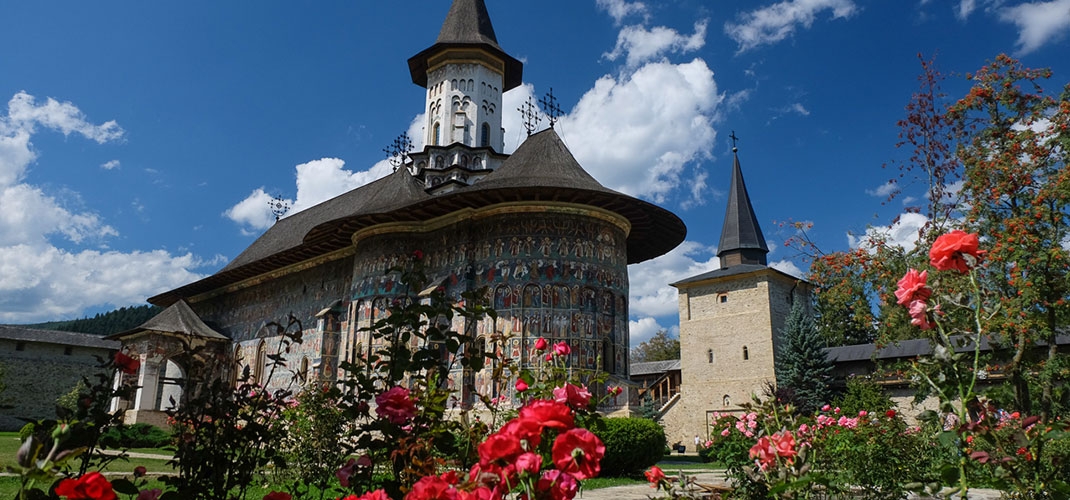Romania

Romania is known for its famous Transylvania region, surround by the Carpathian Mountains as well as its wonderfully preserved medieval towns including Sighișoara, its fortified Churches and Bran Castle. With exceptional climbing, trekking and skiing adventures you can travel from the Danube River Delta to Bucharest and then on to the Black Sea in just a few hours.
Bucharest, Romania’s Capital is a very vibrant city. The most iconic landmark is the Communist era Palatul Parlamentului Government building with 1,100 rooms, it is the second largest building on the planet. Bucharest enjoys everything from the nightlife in the Lipscani district to the 15th Century Curtea Veche Palace where Vlad the Impaler once ruled. Other sites to visit include the Romanian Athenaeum and Cismigiu Garden. The city is a combination of modern capitalism and remnants of the Communist era, 17th Century Churches, lovely parks and trendy cafés.
Brașov is one of the most visited locations in Romania, located in Transylvania and surrounded by the Carpathian Mountains it is home to the towering 13th Century Black Church with its 4,000 pipe organ. This is modern city with an old world charm, with stunning landscapes and a rich history. Braşov is a maze of streets and cafés, which you will love strolling through and the focal point is Piata Sfatului (Council Square) and the Casa Sfatului (Local Museum). Close to Braşov, Bran Castle dates back to 1377 and is one of Romania’s top tourist destinations. This medieval hilltop Castle has been marketed as Bram Stoker’s inspiration for Dracula’s Castle and is situated on the border of Transylvania and Wallachia. Today, the Museum exhibits art and furniture collected by Queen Marie, who called the Castle her home in 1920.
Located on the Cibin River in Transylvania, Sibiu was named the 2007 European Capital of Culture and is considered a jewel due to its Baroque squares and quaint cobblestone streets, history, gastronomy and diverse architecture. Romania’s first Library, Pharmacy and Hospital were all created in Sibiu. Some of the main places to visit include The Brukenthal National Museum with its Romanian artwork, the Gothic Church with 6,002 pipes, the Church Tower, the Tomb of Prince Mihnea the Bad, who was murdered in front of the Church and the ASTRA National Museum Complex an Open-Air Museum.
Sighișoara, the medieval UNESCO World Heritage Site, dates back to the 12th Century. With nine towers including the 64 metre high Clock Tower built in 1556, colourful Burgher houses, cobbled streets and stunning Churches, it has a special ambiance and atmosphere. Sighișoara is also the birthplace of Vlad Dracula, known as Vlad the Impaler who ruled during the 15th Century. You can visit his home as well as the Church on the Hill, the Dominican Monastery and the Venetian House. Only 30 kms from Sighișoara, is the beautiful village of Biertan and home to one of the largest and most impressive medieval strongholds in Transylvania. Surrounded by quaint streets and vineyards the 15th Century Biertan Fortified Church is a UNESCO World Heritage Site, which is perched high on a hill in the middle of the village.
Cluj-Napoca is a vibrant University town and the unofficial capital of Transylvania. The city dates back the 2nd Century A.D. Dacian settlement and is home to The Romanian National Museum of Art. This charming city also serves as Romania’s film capital holding the Transylvania International Film Festival every May. Sites not to be missed include the Piata Unirii, a 14th Century Gothic Church, the Baroque-era Bánffy Palace, now home to a Romanian Art Museum and a statue of the 15th Century King Matthais Corvinus. Cluj often serves as a starting point for trips to the nearby Apuseni Maramures Mountain ranges. Just an hour from Cluj the Salina Turda is a salt mine located in the Durgau-Valea Sarata. This eclectic village with its colourful Hapsburg façades is one of the most visited sites, with around 1000 varieties of plant and animal species in this small area, some of which are rare or endangered.
Suceava is the entry way to the Bucovina region, home to the Painted Monasteries. Suceava has some of the most incredible landmarks, including the UNESCO World Heritage Site of Saint George’s Church, the Bucovina Ethnographic Museum and the Princely Court. Bucovina’s Painted Monasteries are truly an amazing site where in the 15th-16th Centuries the exterior walls of a handful of Monasteries were painted in colourful frescoes. Originally, they were painted to make the stories of the Bible available to all of the surrounding villagers. The scenes feature masterpieces of Saints, Prophets, Jesus, Angels, Demons plus heaven and hell and the Churches are now UNESCO World Heritage Listed Sites.
Timișoara is a key social and cultural centre, often called Primul Oras Liber (First Free Town) due to it being where the first anti-Ceausescu protests broke out, which ultimately led to their demise. Dating back to the 13th Century many cultures laid claim to the city including Romans, Turks, Serbs and Austrians. Timișoara has a lot of beautiful parks and gardens and public squares and also has year round music festivals, art exhibits and museums.
The quaint mountain resort of Sinaia is situated in a small valley filled with fir trees. Most people visit the region to see the stunning Peles Castle an exceptional example of Neo-Renaissance architecture. Decorated with ornate stonework, sculpted wood and stained glass windows, the Castle is not only charming but intimidating set against the panoramic views of the Carpathian Mountains. King Carol I built this Castle in the 19th Century as a summer home. Today, the Castle serves as a museum, showing off a collection of artwork, armour and weaponry.
Found in Hunedoara, one of the best Castles to visit while in Romania is Corvin Castle. Also known as Hunyadi Castle, it’s one of the largest in Europe however, there is also a lot more to see while here including the nearby Cinci Lake and the Nandru Cave, the Furnace of Govajdia and St. Nicholas Church.
The Danube Delta is one of the largest and best preserved Delta’s in all of Europe, a winding system of waterways that originates from the Black Sea with its 23 ecosystems that are home to a huge number of plants and wildlife. With a total size of 5,165 square kilometres the Delta is listed as a UNESCO World Heritage Site. The sleepy fishing Port of Sulina with its tranquil beach is a great place to visit on any Danube Delta discovery. Sulina makes a great base to explore the Delta region and along the Black Sea. You will find anything from Monasteries to a diversity of wildlife in this small beautiful town.
The city of Constanța is a hot spot on the Black Sea with its coastline of sandy beaches buzzing with visitors during the summer months. One of the most visited resorts is Mamaia; this lively resort sits on a thin strip of land between the Black Sea and Lake Siutghiol. The Port of Constanța‘s is the largest in the Black Sea’s basin and the main seaport in Romania.
Filter Results
Trip Duration
Price Range
Country Destinations
Select Countries to Visit
City Destinations
Select Cities to Visit
Tour Categories
Select a Tour Category
Filter Results
Trip Duration
Price Range
Country Destinations
Select Countries to Visit
City Destinations
Select Cities to Visit
Tour Categories
Select a Tour Category
